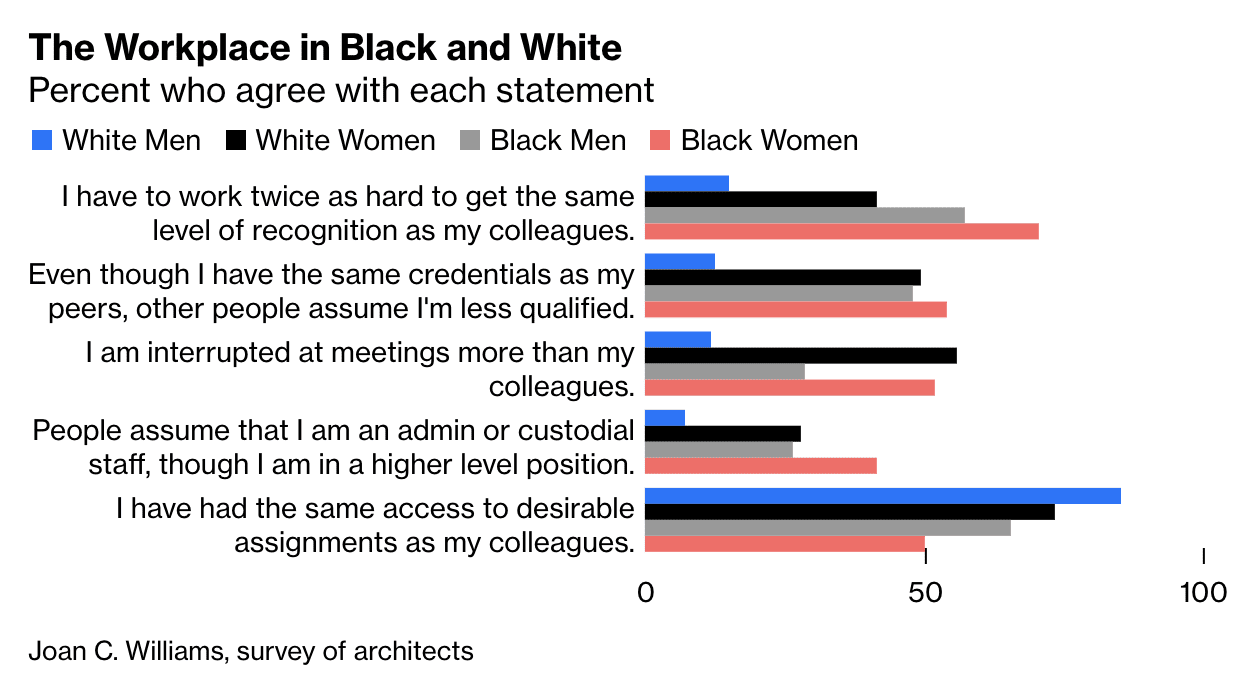Op-Ed: Companies Have the Tools to Fight Racism. Will They Use Them?
I keep getting emails from companies saying they stand in solidarity with black Americans and oppose racism. Super, glad to hear it. My reaction, though: What’s the racial makeup of your board of directors? Who succeeds in your organization? Who gets promoted? The social display of empathy is a good first step, but it’s time for corporations to do more.
Research I’ve led in industry after industry shows just how much work remains to be done. Our surveys of lawyers, architects and engineers confirm that the experience of black professional women diverges dramatically from that of white men. For example, only 15% of white male architects feel they have to work twice as hard to get the same level of recognition as their colleagues; 71% of black women do.

While we measured perceptions, there’s plenty of hard data out there to show that black women’s perceptions are correct: they do need to be more competent and accomplished than any other group in order to get ahead. For example, one study found that black women are rated even more harshly for failure at work than black men and white women due to the “double jeopardy” of their intersecting identities. Perhaps not surprisingly, our research shows that black professional women are more likely than any other group of women to say they are treated unfairly with respect to hiring, assignments and promotions.
Office politics also are more complicated for black women. Organizations accept a narrower range of behavior from black women, who are the group most likely to report pushback for showing anger. Black women need walk a tightrope, balancing assertiveness with deference, much more so than white women, who themselves face a tightrope compared to white men. White men just need to be authoritative, and can use anger to draw a “Don’t tread on me” line.
The workplace is also lonelier for black women. In our survey of 557 science professors, we found that 76% of women of all races felt that women typically support other women; only 56% of black women science professors agreed. Across our samples, black women were by far the least likely group of women to feel that they have a lot in common with other women. White women seem to be assuming a shared sisterhood black women don’t see.
Our interviews of science professors also found that black women reported, in a tone of bleak isolation, a level of disrespect I have never heard again in my hundreds of interviews with professional women. One biologist described her experience as one of “Isolation … you don’t know who you can trust … And alienating — this has been a very lonely life.”
There’s been a lot of corporate handwringing about how hard it is to produce a level playing field, spurred by research that shows that most diversity initiatives are ineffective.
It’s not that hard.
Businesses have failed to make progress on diversity because they have never bothered to pick up the tools they use to solve any problem they actually care about. If a business had a problem with sales, the response would not be to hire someone to lead the company in deep conversations about how fervently the company cares about sales and put on programming for National Celebrate Sales Month. The business would gather the evidence, establish metrics, and keep trying different things until it achieved its sales goals.
We don’t use that approach to bring equity to organizations — but we should. That same data-driven, experimental approach can be used to fight racism and sexism in the workplace. We have 40 years of social science data documenting the distinct patterns of bias that affect women and people of color. We can use this data to pinpoint where bias plays out in business contexts and then interrupt that bias with new, evidence-based processes.
I call these tweaks to hiring, performance evaluations, and other HR systems “bias interrupters” because they don’t really require changing how people think, as so many implicit bias trainings try (and fail) to do. Instead, they interrupt bias by changing business systems and routines.
For example, a company facing diversity challenges in hiring should be keeping metrics: tracking the demography of the initial applicants, monitoring which resumes get to the top of the pile, logging who gets interviewed and who gets offers. Knowing exactly where underrepresented candidates are getting pushed out of the process matters because the fix for diversifying the initial pool is very different from the fix when only well-connected white men are getting high marks for interviews. For the former, the key is reaching out to a broader range of networks — for example, to career centers at historically black colleges and universities. For the latter, the key is a combination of structured interview questions, grading rubrics, and making interviewers aware of the patterns of bias that crop up in job interviews. Changing these business systems is how we turn lofty CEO statements into real progress.
During the time it took me to write this, I got yet another email from a white-led organization telling me I need to feel uncomfortable about racism. I do. But this is not about white people’s emotions. This is about finally delivering on America’s promise of racial equality.
This column does not necessarily reflect the opinion of the editorial board or Bloomberg LP and its owners.
To contact the editor responsible for this story:
Sarah Green Carmichael at sgreencarmic@bloomberg.net
This opinion piece was originally published on Bloomberg.com on June 12, 2020.